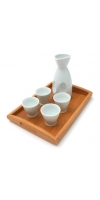Hattan, Chusei Shinsenbon(Sake)

The Kamoizumi Nigori Ginjo Summer Snow from Timeless Wines is unique premium sake that boasts of delicious flavors. This strong unfiltered sake is fresh and semi-sweet sake that gives elegance to the name. This Summer Snow is light and fresh, compared with very sweet and strong sakes that are crafted in the United States. Since the Kamoisumi Brewing Company sits in the region of Saijo, the region’s water source and climate lends to the flavor of this fine sake. Good quality rice is used to craft the famous sakes that come from this brewery. The founders of the Kamoisumi Brewing Company were initially rice farmers who progressed to rice milling and sake brewing. In the mid 1960’s the brewery was one of the breweries that continued with junmai sake production, although breweries all over the country abandoned the process due to monetary gain. The brewery announced its first junmai sake in the 1970’s, although some breweries removed impurities from the sake with a charcoal method. Since the Kamoisumi Brewing Company believed these components shaped the characteristic of the sake, they maintained the nature of the sake and continued to brew with traditional methods. There is no brewery in Japan that has kept its level of individuality and the sakes produced in this brewery are truly distinct. Due to the brewery’s distinct reputation, the Kamoizumi Nigori Ginjo Summer Snow is a fantastic choice of sake.
No products found
- back
Selected Options
Grape Types
Categories
Pricing
Countries
Regions
Grape Types
Wineries
Organic/Free Shipping
Certified organic, ungrafted vines over 130 years old; a "grand cru" site of Paso Robles. Transcendent. Lovely sweet red fruits, loads of spice and pepper, violets, chalk, even a hint of pineapple grass on the nose. White stones and wild strawberries in a lovely pas de deux on the palate, with vibrant energy and finesse. What a knockout.
Review:
Broad-shouldered and powerfully structured yet detailed and stylish, with deep flavors of blackberry and cherry accented by bittersweet chocolate, orange peel and fruitcake spices that gather tension and richness on the slightly firm finish.
-Wine Spectator 95 Points
Pago de Carraovejas El Anejon is made from 93%, Cabernet Sauvignon 5% and Merlot 2%.
El Anejon vineyard is a terraced plot on a steep slope, oriented toward the sun and with great views of the Castle of Peñafiel. The soil of the narrow terraces has a compact, loamy limestone texture. The presence of the white-colored limestone calcium salts contributes to a distinctive minerality in this wine. Only made in exceptional vintages.
Review:
"A single-plot wine from the top terraces of the site from an excellent vintage, the 2021 El Anejon is powerful and truly outstanding. Tempranillo is blended with Cabernet Sauvignon and Merlot to an exceptional end, aged 12 months in larger French oak barrels after a triple selection of the grapes. Sharp red fruit has an underbelly of herbal earthiness beneath the fruit, while tight, refreshing acidity accentuates the mineral-driven texture. Bottled in June 2023, this might be the producer’s best wine of the vintage, which is saying a lot, as they’re all of outstanding quality. This will hit a high point in 5-7 years and keep going another 20. - Virginie BOONE"
- Jeb DUNNUCK (August 2°25), 98 pts




